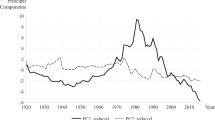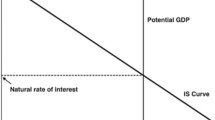Abstract
In this paper a loanable funds model is estimated over the period 1959–1990 for the determination of after-tax expected real interest rates using aggregated data for four European countries under the assumption that high capital mobility in Europe implies a common capital market. It is concluded that real interest rates in the European Community were mainly driven by movements in temporary income, expected inflation, lagged investment, money growth, and the oil price. Moreover, our aggregate, model appears to be reasonably stable. Finally, individual country rates are shown to depend on the European rate as well as some country-specific variables, suggesting a limited degree of isolation from international financial markets for the countries concerned.
Similar content being viewed by others
References
Allen SD (1990) The effect of federal deficits and debt on the tax-adjusted, short-term real interest rate. Economic Letters 34:169–173
Aschauer DA (1988) The equilibrium approach to fiscal policy. Journal of Money, Credit, and Banking 20:41–62
Atkinson P, Chouraqui JC (1985) The origins of high real interest rates. OECD Economic Studies 5:8–55
Barro RJ, Sala-i-Martin X (1990) World real interest rates. NBER Macroeconomics Annual 15–74
Beveridge S, Nelson CR (1981) A new approach to decomposition of economic time series into permanent and transitory components with particular attention to the measurement of the ‘business cycle’. Journal of Monetary Economics 7:151–174
Bhandari JS, Mayer TH (1990) A note on saving-investment correlations in the EMS. IMF Working Paper: 90/97
Blanchard OJ (1985) Debt, deficits, and finite horizons. Journal of Political Economy 93:223–247
Blanchard OJ, Summers LH (1984) Perspectives on high world real interest rates. Brookings Papers on Economic Activity 273–324
Cover JP (1992) Asymmetric effects of positive and negative money-supply shocks. Quarterly Journal of Economics 107:1261–1282
Cumby RE, Obstfeld M (1984) International interest-rate and price-level linkages under flexible exchange rates: A review of recent evidence. In: Bilson J, Marston R (eds) Exchange Rate Theory and Practice. Chicago 121–151
Cumby RE, Mishkin FS (1986) The international linkage of real interest rates: The European-US connection. Journal of International Money and Finance 5:5–23
Gagnon JE, Unferth MD (1993) Is there a world real interest rate? International Finance Discussion Papers 454, Board of Governors of the Federal Reserve System, Washington DC
Granger CW, Newbold P (1977) Forecasting economic time series. Academic Press New York
Haan J de, Zelhorst D (1992) The intertemporal substitution effect of government purchases on the interest rate: Empirical estimates for the Netherlands. Empirical Economics 17:293–302
Hamilton JD (1983) Oil and the macroeconomy since world war II. Journal of Political Economy 91:228–248
Knot KHW, de Haan J (1995) Fiscal policy and interest rates in the European community. European Journal of Political Economy: forthcoming
Koedijk CG, Kool CJM, Kroes TRPJ (1994) Changes in world real interest rates and inflationary expectations. Weltwirtschaftliches Archiv 130: 712–729
Kremers JJM, Lane TD (1990) Economic and monetary integration and the aggregate demand for money in the EMS. IMF Staff Papers 37:777–805
Mark NC (1985) Some evidence on the international equality of real interest rates. Journal of International Money and Finance 4:189–208
Miller SM (1988) The beveridge-nelson decomposition of economic time series; another, economical computational method. Journal of Monetary Economics 21:141–142
Mishkin FS (1984a) The real interest rate: A multi-country empirical study. Canadian Journal of Economics 17:283–311
Mishkin FS (1984b) Are real interest rates equal across countries? An empirical investigation of international parity conditions. Journal of Finance 39:1345–1357
Mundell R (1963) Inflation and real interest. Journal of Political Economy 71:280–283
Neftçi SN (1984) Are economic time series asymmetric over the business cycle? Journal of Political Economy 92:307–328
Plosser CI (1987) Fiscal policy and the term structure. Journal of Monetary Economics 20:343–367
Sims CA (1980) Comparison of interwar and postwar business cycles: Monetarism reconsidered. American Economic Review, Papers and Proceedings 70:250–257
Stevenson A, Muscatelli V, Gregory M (1988) Macroeconomic theory and stabilisation policy. Oxford
Tanzi V, Lutz MS (1993) Interest rates and government debt: Are the linkages global rather than national? In Verbon HAA, van Winden FAAM (eds) The Political Economy of Government Debt. North-Holland Amsterdam 233–254
Wilcox JA (1983) Why real interest rates were so low in the 1970's. American Economic Review 73:44–53
Author information
Authors and Affiliations
Additional information
At the time of writing the author was still affiliated with the Department of Economics at the University of Groningen. Hence, any views expressed here are those of the author and do not necessarily represent those of De Nederlandsche Bank. This paper benefitted very much from stimulating comments made by Willem Buiter, Kanhaya Gupta, Jakob de Haan, Flip de Kam, Kees Koedijk, and an anonymous referee. The author would like to thank Jan-Egbert Sturm for technical assistence. Of course, the usual disclaimer applies.
Rights and permissions
About this article
Cite this article
Knot, K. On the determination of real interest rates in Europe. Empirical Economics 20, 479–500 (1995). https://doi.org/10.1007/BF01180678
Received:
Revised:
Issue Date:
DOI: https://doi.org/10.1007/BF01180678




